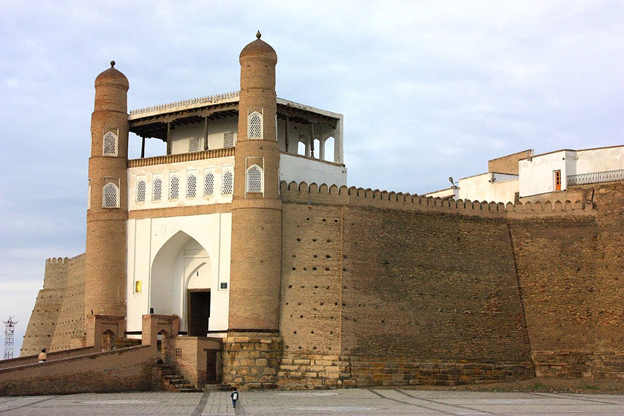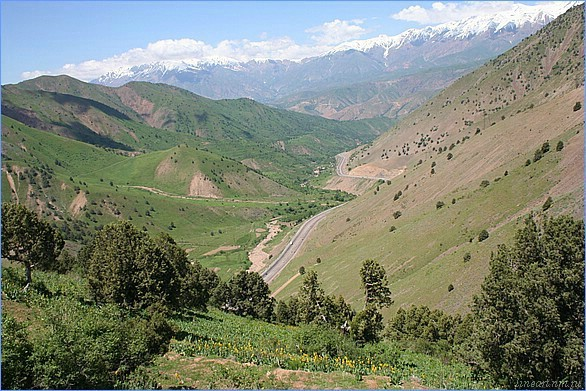@Rob_Haug back for my final day here @HistorianofIran. I hope you can tell that I’ve really enjoyed posting here the past week. Unfortunately that means I’ve gone off on tangents and down rabbit holes which have kept me from my intended schedule. rh 1/
So, tonight I want to wrap things up and talk a little bit about Umayyad Central Asia and the slow process of integrating the east into the caliphate… a process that was perhaps never finished. Let’s start with the conquest of Sogdiana. Rh 2/
As I was describing yesterday, early incursions into Transoxiana did not establish a permanent Muslim presence. Armies came, obtained spoils, and went back to Marw. These were summer campaigns and the Arabs were not prepared to winter beyond the Oxus. Rh 3/
We have multiple reports of campaigns that ended as soon as it got too cold, including one to Khwarazm on the southern shore of the Aral Sea during which the Muslims had to take clothes from slaves they had captured, causing many of them to freeze to death. rh 4/
Sogdiana fell under Umayyad control during the governorship of Qutayba b. Muslim (705-715). This was a long campaign taking many years which I won’t detail here. Rather, I will highlight the key innovation of Qutayba’s campaign, the establishment of a garrison in Bukhara. Rh 5/
His first attempt at a garrison was at Paykand, but as soon as the army moved on, the people rose up and killed the occupiers. Retaliation was quick and total, destroying the city. Accounts tell the merchants of the city were away trading in China and when they returned... rh 6/
They ransomed the people who had been taken as slaves and rebuilt the city from scratch. Mostly, this is another report about the wealth of the Paykandi merchants and the importance of the trade with China. Fantastical reports have Qutayba trying to reach China himself. Rh 7/
In Bukhara, 1/2 of the houses and estates in and around the city were taken for the garrison and the people were to supply them with fodder for the horses and firewood. 200 years later, we have reports of people petitioning for the return of land confiscated at this time. Rh 8/
One shift we can track in this moment is the movement of urban merchants to rural estates which became a new center of resistance. By 712, a mosque was constructed. In an attempt to lure locals to Islam, it is reported that Qutayba took an unorthodox route… rh 9/
Qutayba had the Quran and prayers read in Persian. Perhaps at such an early date the resistance to translating the Quran was not so universally accepted, especially in a distant place like Bukhara. He also paid everyone who attended prayers 2 dirhams. rh 10/
Qutayba& #39;s expansion into Transoxiana impacted local politics. For example, initially the Ikhshid of Samarqand, Tarkhun resisted Umayyad expansion and sent troops to defend Bukhara, but later he capitulated and agreed to pay tribute. This upset some of his subjects. rh 11/
And in 710 the Samarqandis deposed Tarkhun and replaced him with a man named Ghurak who promised a firmer hand against the Muslims. But when Qutayba arrived at the city with his army in 712, Ghurak capitulated and offered not only to build a mosque in the city... rh 12/
He also offered to evacuate the city while the Muslims prayed. Qutayba used this opportunity to lay claim to the city. He barred non-Muslims from staying in the city over night. Generally, he treated the city as if it had been conquered by force despite Ghurak& #39;s surrender. rh 13/
In the following years, Qutayba would take his forces all the way to the Ferghana valley, Tashkent, and the Jaxartes River, but these exploits ended quickly in 715 when the Caliph Walid (r. 705-715) died and was succeeded by his brother Sulaymn (r. 715-717). rh 14/
Sulayman did not like Qutayba or his recently deceased mentor in Iraq, Hajjaj b. Yusuf, and so removed Qutayba from his position so he could be replaced with an ally from the Muhallabid family. This news arrived while Qutayba and his troops were in Ferghana. rh 15/
And he decided to take advantage of his remoteness. Qutayba tried to rally his troops, reminding them of their great victories and the spoils they had won together. He then asked them to resist the new governor and rebel in his name. They didn& #39;t and Qutayba was killed. rh 16/
The death of Qutayba ends the period of military expansion in Central Asia for awhile. After him came a period of consolidation of power. One of the reasons this happened like this is because of the position of the Turks in the late 7th and early 8th centuries. rh 17/
Around 630, the Tang Empire of China had been able to assert their authority over their northern frontier and broke the Eastern Turk Khaqanate. These are the Turks who had pressured Chinese dynasties and received silk tribute that was then exported west. rh 18/
At around the same time, the Western Turk Khqanate had also destabilized due to political infighting, dividing into 10 warring factions. This had left Sogdiana without the military backing of the Turks except for what mercenaries they could hire. This was about to change. rh 19/
By 716, the Turgesh Turks had come out of this conflict the winners and began turning their attention back towards Sogdiana, with the first Turkish incursions attacking Muslim garrisons in 720. At the same time, the Sogdians were beginning to chafe under Muslim rule. rh 20/
Besides the looming threat of the Turgesh, the Umayyads had numerous troubles to address in Transoxiana related to the integration of conquered peoples into the empire. 1. How should you treat converts? 2. How do you tell a sincere from an insincere convert? rh 21/
3. How do you shift imperial finances from a conquest and spoils model to a management and taxation model? The answers to these questions were not consistent from one governor to another or one caliph to another. The Caliph Umar II (r. 717-720) for example was pro convert. rh 22/
In theory, converts were supposed to be free of the jizya, a poll tax levied on non-Muslims, but, in the early days, this tax made up a major portion of the caliphate& #39;s finances. Governors who were expected to remit tax payments to Syria were challenged by conversions. rh 23/
Conversion took imperial subjects off the tax roll. There was also a question whether someone was converting out of a true faith or because they wanted a tax break, so you found many governors continuing to collect the jizya from people who claimed to be converts. rh 24/
Umar II dismissed his governor Jarrah b. Abdallah al-Hakami for this practice. Jarrah instituted a public circumcision test to prove converts had gone all the way. When Umar heard this, he told Jarrah "God sent Muhammad to summon people to Islam, not to circumcise them". rh 25/
This continued to be a problem. In the year 728, the chronicler Tabari has a group of Bukharan gentry, responsible for collecting taxes in the villages, asking the governor Ashras b. Abdallah al-Sulami "who can we take the taxes from now that everyone has turned Arab?" rh 26/
Such unfair and inconsistent treatment pushed many Sogdians away from the Umayyads. In 719, records from the Tang court have representatives of the Bukharkhuda, the Ikhshid Ghurak, and local lords of several smaller principalities asking for help to overthrow the Muslims. rh 27/
In 721, a large group from Samarqand, attempted to flee for the Ferghana Valley, outside of Umayyad reach. They made it to Khujanda at the mouth of the valley before the Umayyad governor Said b. Amr al-Harashi captured and slaughtered them. Another group ran to Panjikent. rh 28/
There they sought protection from a local lord named Diwashtich, but Harashi pursued them too, stormed Panjikent & executed Diwashtich. As mentioned earlier, the frescoes & documents found by archaeologists at Panjikent offer us some of our best sources for this period. rh 29/
These revolts were further aided by the rising power of the Turgesh. In 724, as an Umayyad force tried to march on Ferghana, but were ambushed by a Turkish force in a disaster known as the Day of Thirst. rh 30/
The Turks harassed the Muslims as they tried to retreat, forcing them to burn their baggage so they could travel more quickly, and when they reached the Jaxartes, the Turks blocked their path and forced them to charge in order to reach needed fresh water. rh 31/
The defeat was so total the Umayyads didn& #39;t attempt another expedition to expand their frontiers in the east.
But it was just the beginning for the Turgesh under their leader Suluk. By the end of the decade, the Turgesh had attacked both Samarqand and Bukhara. rh 32/
But it was just the beginning for the Turgesh under their leader Suluk. By the end of the decade, the Turgesh had attacked both Samarqand and Bukhara. rh 32/
In 731, during the Battle of Pass a relief force marching from Balkh to relieve a siege at Samarqand was ambushed in the mountains, almost completely wiping out both the relief force and also a Muslim force that had sallied out from Samarqand to relieve the relievers. rh 33/
The end result was that the Umayyads were pushed out of Transoxiana almost entirely for the next decade, until after the death of Suluk.
This is all to say that the conquest of Transoxiana was a decades long process that was impacted by many different factors. rh 34/
This is all to say that the conquest of Transoxiana was a decades long process that was impacted by many different factors. rh 34/
Beyond the integration of the Sogdians into Umayyad imperial structures and the emergence of the Turgesh, I have not even gotten to tribal conflicts among the Arabs. But, alas, my time here at @HistorianofIran is coming to a close. rh 35/
I hate to leave you all in the middle of the story... so hopefully @sasanianshah will invite me back some other time to talk a bit more about frontiers. Thank you all for reading these past 7 days. I will try to put this all into a digest format soon.
Cheers,
@Rob_Haug
Cheers,
@Rob_Haug

 Read on Twitter
Read on Twitter





